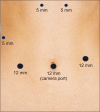Laparoscopic pancreas-preserving near total duodenectomy for large villous adenoma in patients with total colectomy for familial adenomatous polyposis
- PMID: 37347102
- PMCID: PMC10280101
- DOI: 10.7602/jmis.2023.26.2.83
Laparoscopic pancreas-preserving near total duodenectomy for large villous adenoma in patients with total colectomy for familial adenomatous polyposis
Abstract
Most familial adenomatous polyposis (FAP) patients undergo total colectomy, but duodenal polyposis develops in up to 90% of patients with FAP and a 4% to 18% risk of duodenal and ampullary cancer remains. Laparoscopic pancreas-preserving near total duodenectomy is thought to be a potential option and can be an effective approach to preserve the pancreas. A 48-year-old male patient, who underwent laparoscopic total colectomy with end ileostomy because of FAP with colorectal cancer, was diagnosed with a 20 mm-sized duodenal adenoma in the second to the third portion. The operation was performed on December 27, 2021. Near total duodenectomy was done and type II Billroth gastrojejunostomy was done. Laparoscopic pancreas-sparing duodenectomy is shown to be safe, with favorable short-term oncologic outcome compared to laparoscopic pancreatoduodenectomy in terms of less blood loss, faster recovery time, and much less total cost.
Keywords: Duodenal neoplasms; Duodenum; Minimally invasive surgery procedure.
© 2023 The Korean Society of Endo-Laparoscopic & Robotic Surgery.
Conflict of interest statement
Conflict of interest All authors have no conflicts of interest to declare.
Figures




Similar articles
-
Laparoscopic Pancreas-Sparing Duodenectomy with Roux en Y Reconstruction for Duodenal Polyposis.Chirurgia (Bucur). 2019 Jul-Aug;114(4):494-505. doi: 10.21614/chirurgia.114.4.502. Chirurgia (Bucur). 2019. PMID: 31511136
-
Comparison of pancreas-sparing duodenectomy (PSD) and pancreatoduodenectomy (PD) for the management of duodenal polyposis syndromes.Surgery. 2019 Oct;166(4):496-502. doi: 10.1016/j.surg.2019.05.060. Epub 2019 Aug 29. Surgery. 2019. PMID: 31474487
-
Laparoscopic pancreas-preserving total duodenectomy for familial adenomatous polyposis.Surg Laparosc Endosc Percutan Tech. 2011 Dec;21(6):e332-5. doi: 10.1097/SLE.0b013e3182397771. Surg Laparosc Endosc Percutan Tech. 2011. PMID: 22146186
-
[A Case of NET G1 of Vater's Papilla in Familial Adenomatous Polyposis-Associated Duodenal Adenomatous Polyposis].Gan To Kagaku Ryoho. 2015 Nov;42(12):1764-6. Gan To Kagaku Ryoho. 2015. PMID: 26805165 Review. Japanese.
-
Gastroduodenal lesions in familial adenomatous polyposis.Surg Today. 2000;30(8):675-82. doi: 10.1007/s005950070077. Surg Today. 2000. PMID: 10955728 Review.
References
Publication types
LinkOut - more resources
Full Text Sources
Miscellaneous

